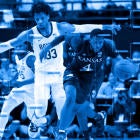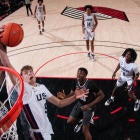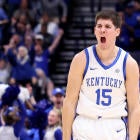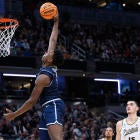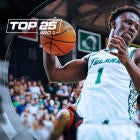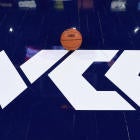This week has been among the most surreal of my life. It has been like watching an avalanche in slow motion. In the span of 48 hours, we went from everything being a full go, to playing the NCAA Tournament in empty arenas, to most of conference tournaments being cancelled over the course about an hour, to the NCAA canceling the full tournament. And all of that came in the middle of every major sport postponing their respective seasons.
Just last Sunday, at halftime of the Wichita State-Memphis game, Dan Gavitt, the NCAA's senior vice president of basketball, talked about the worst case scenario as having to play games in empty arenas. I felt like that was also the worst case scenario unless outside forces intervened. That intervention started primarily with the Governor of Ohio when he said he was going to order a ban on large gatherings on Wednesday. However, when it was reported that night that Utah Jazz forward Rudy Gobert tested positive for the coronavirus and the NBA suspended its season, the NCAA's hand was forced again.
On Thursday, I was standing in the CBS Sports HQ studio in Stamford, Connecticut, looking at nothing but blank screens where games should have been. However, there was one exception. The Big East decided to play the first half of the St. John's-Creighton game. One lonely game that everyone surely had to know would not be finished. I will never understand why that was allowed to begin, and more to the point, why it wasn't canceled sooner. Surely the league decision to cancel the tournament wasn't made at halftime since it was announced immediately then. Why let the players risk injury in a game that wouldn't count?
On Friday, two days before Selection Sunday, I was supposed to be in a studio in the CBS Broadcast Center all day and late into the evening talking to you about the implications of the day's games. The same was true for the next two days. I had also been assigned to St. Louis and Indianapolis for the NCAA Tournament to report for HQ. Instead, I flew home Friday, where I am now writing this and it will likely be the last thing I write this season.
CBS Sports was the first to report that the NCAA selection committee may try to produce a "final" bracket, based on the results prior to the cancellation. That seems like a very cumbersome task at best. The committee has a five-day, in-person meeting to produce the real one. I can't imagine that could happen now, but they also would not have to react to results that occur during the regular meeting. Regardless, I doubt they could be as thorough as they usually are. And, frankly, you have to wonder if this is the best use of the time of the committee members, who are all athletics directors and conference commissioners that have bigger issues to deal with.
However, if they do give us a bracket, keep in mind that it will also not based on a full season. For the teams at the bottom of the bracket, just because you are in this one does not mean you would have been in a full season bracket. We do not have a full season of results for the same reason we do not have an NCAA tournament.
So, here are some highlights of my final bracket projection of the season, which of course, is also not based on a complete season.
Top seeds in Palm's Bracketology
Kansas, Baylor, Gonzaga and Dayton are the No. 1 seeds and in that order. Only Gonzaga completed its season and did so by winning the West Coast Conference championship.
Kansas has been the most complete and accomplished team this season and is a solid No. 1 overall. No team can match its 12 quadrant 1 wins and only one of those wins came against a team not in contention for the NCAA Tournament. The lowest ranked team in the NET to beat them was No. 13 Villanova.
Baylor struggled down the stretch a bit, losing three of its last five. The Bears cushion was so large though that their overall resume is still easily the second best of this group. In fact, a Baylor win over Kansas – and it would have to be Kansas – in the Big 12 title game would have given the Bears a good case to be No. 1 overall, although I think it still would have been the Jayhawks. Alas, we'll never know.
Gonzaga had another outstanding season and may have been Mark Few's best team at the school. The Bulldogs will finish with the top ranking in the NET, for what that's worth. The uncapped margin of victory component of the NET allowed the Zags to compensate for a less daunting overall schedule than their competitors at the top of the bracket. Their only losses came at BYU and to Michigan in the Battle 4 Atlantis.
The fourth No. 1 seed is Dayton, which I moved ahead of San Diego State after the Aztecs lost the Mountain West tournament final to Utah State. Dayton's best win came over St. Mary's, but they stomped their way through the Atlantic 10 and the Flyers only losses were to Kansas and Colorado, each on neutral floors and each in overtime. They were basically two points from undefeated.
Dayton's overall strength of schedule was better than San Diego State's, but the Aztecs had better wins, including victories over Creighton, BYU and Iowa, none of which came at home. So, it isn't a sure thing that Dayton would have received the top spot from the committee as well. For sure, the Flyers would have had to win its conference tournament. The Aztecs season was complete.
Fighting for No. 2: There were no other contenders for the top line of the bracket, which is weird to say since Florida State was the regular season ACC champion and a No. 2 seed in this bracket. The Seminoles were denied an opportunity to play for an ACC tournament championship, the only one the ACC recognizes, and possibly bolster its resume. Unfortunately, the league just wasn't good enough this season below the top four for FSU to get the kind of quality wins it would have needed to compete for a No. 1 seed.
There are a lot of questions that will remain unanswered. For example, how high could teams like Duke, Kentucky, the top teams in the Big Ten and Big East have risen with strong conference tournaments?
Battle on the bubble: Many of those questions are at the bottom of the bracket. Would Rutgers make its first appearance in the NCAA Tournament since 1991? Beating Michigan would have made it a lock. The Scarlet Knights might have gotten in anyway even with a loss. In that case, they would have been the first team to get a bid with fewer than three wins away from home since 1994. Rutgers was 2-10 away from the RAC this season.
The highest ranked team in the NCAA's metric of choice – the NET now, the RPI prior to last season – to miss the NCAA tournament was Missouri State in 2006, which was 21st in the RPI. However, three major conference teams were ranked in the 30s of the NET last season missed the tournament because of major resume flaws. Those teams were No. 33 NC State (horrible non-conference schedule), No. 35 Clemson (1-10 vs Q1) and No. 38 Texas (16-16 overall). In the last 25 seasons that were RPI-based, only seven power conference schools ranked in the 30s missed the field, although two of those came in 2018, the last season of the RPI.
This season, NET No. 22 Texas Tech was in danger of threatening that record. The Red Raiders had a very poor record against better competition, but in particular, they entered the Big 12 tournament at 10-13 vs Q1-3. Only one team had ever received an at-large bid that was two games below .500 against that group of teams (Temple, 2016). Texas Tech was due to play a Big 12 quarterfinal with Texas, which was also squarely on the bubble and among my first four out.
One other thing Texas Tech had in common with the three teams that missed last year is that each of those team's RPIs were significantly lower than their NET rankings. Don't get me wrong – the committee was not looking at RPI numbers. I might have been the only person publishing them. However, the quality of those teams' resumes was more accurately reflected in the RPI and the committee was not fooled by the NET rankings. We should not assume the committee would have been fooled by Texas Tech's NET ranking either.
At the other end, UCLA was threatening to break the record for the worst ranking to get an at-large bid. That is still held by New Mexico, which was 74th in the RPI in 1999. Last season, St. John's got in at No. 73 in the NET. The Bruins entered Pac-12 tournament play ranked 76th in the NET and was scheduled to play ten-seed Cal in their first game. They would have been in trouble with a loss to the Bears.
NC State, also among my first four out, missed out on a chance to beat Duke on a neutral floor and likely seal a spot in the field. I cannot say for sure they would have missed with a loss, but the one thing that stands out on the Wolfpack's resume is the high number of losses to non-tournament contenders, including sweeps by Georgia Tech and last-place North Carolina.
So many questions left unanswered. In the world of sports, that will be the theme for at least the spring of 2020.




















